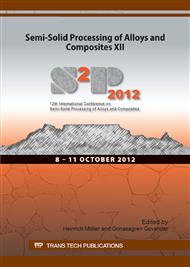p.329
p.335
p.341
p.347
p.353
p.359
p.365
p.373
p.379
Wall Slip Effect in Couette Rheometers
Abstract:
Wall slip of suspensions in confined flow is caused by segregation of a thin layer of liquid phase adjacent to the walls. This causes the bulk phase to slide along the walls, which means that the fluid flow velocities respective to the walls are not zero. In rheometers this affects the evaluation of the rheological properties. Despite the importance of understanding and controlling segregation effects, little research has been done on this subject area. Indeed in industrial casting, the die filling behaviour, and therefore the product quality, may depend on the segregation phenomena. It is important to understand the wall slip phenomenon’s correlation with experimental parameters, as a step towards casting process optimization. Two issues are handled in the present work, the first is the evaluation of different methods to investigate the wall slip effect, the second is the investigation of the wall slip effect dependency on the suspension parameters particle size and solid fraction, respectively. The suspensions employed for the investigations were the aluminium alloy A356 in semi-solid form and a “synthetic suspension” built up of glass spheres in silicon oil. As a result of the above described investigations, influence of suspension parameters are found, and a validated method to avoid the wall slip effect is suggested.
Info:
Periodical:
Pages:
353-358
Citation:
Online since:
October 2012
Authors:
Keywords:
Price:
Сopyright:
© 2013 Trans Tech Publications Ltd. All Rights Reserved
Share:
Citation:


